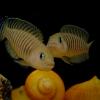Air Stone: Do You Use It Or Not
#1

Posted 04 August 2014 - 11:26 AM
I have a malawi tank with heaps of water movement and surface agitation. Haven't used an air stone for one year now and everything's fine.
Have people experienced any issues with not using an air stone?
#2

Posted 04 August 2014 - 12:03 PM
I don't like seeing heaps of cords, air lines, hardware etc in my tanks. An inlet/outlet from filters are hard to get around, but things like air stones can be eliminated like you say by directing filter return to agitate the water surface. Replace heaters with the in-line options etc all help to give your tank as clean a look as possible.
#3

Posted 04 August 2014 - 12:19 PM
They are quieter.
Also, when used on modified uplifts, I found I got more flow
#4

Posted 04 August 2014 - 12:37 PM
I don't use them because I don't like the ambient buzzing noise, but have one handy if needed. Surface agitation via Eheim pro 3e canister spray bar seems sufficient. If additional aeration is required, a venturi is preferred over airstones.
#5

Posted 04 August 2014 - 12:48 PM
I don't like seeing heaps of cords, air lines, hardware etc in my tanks. An inlet/outlet from filters are hard to get around, but things like air stones can be eliminated like you say by directing filter return to agitate the water surface. Replace heaters with the in-line options etc all help to give your tank as clean a look as possible.
Same as me! Have you experienced inline (external) heaters? Does it still run when doing water changes, as the canister would still be running too? So the water in the tank shouldn't change much when doing a water change? sounds nice..
They are quieter.
Also, when used on modified uplifts, I found I got more flow
true! atm i got great flow, anymore and i think it may be overkill
I don't use them because I don't like the ambient buzzing noise, but have one handy if needed. Surface agitation via Eheim pro 3e canister spray bar seems sufficient. If additional aeration is required, a venturi is preferred over airstones.
My tank is silent, absolutely no noise at all (which i love), i'm using two wavemakers at opposite ends plus my spray bar
Edited by abc123, 04 August 2014 - 12:49 PM.
#6

Posted 04 August 2014 - 12:59 PM
#7

Posted 04 August 2014 - 01:36 PM
I dont use any extra air unless there is a good reason such as medicating or excessive heat during summer.
With Canisters I drill in an air line into the return to get some air into the water OR have the spray bar set just at or above the surface.
Sumps I do nothing as the flow in to the sump oxygenates the water just fine.
I run sponges with power heads on them in a few tanks (including a 600ltr tank) which seems to adequately agitate/oxygenate water.
#8

Posted 04 August 2014 - 03:22 PM
I used to think I didn't need one. But I found that the fish seemed much fiestier after have an Airstone put in with a nice curtain of bubbles.
Also the bubbles create a 'water draft' which can pick up debris off the floor of your tank.
#10

Posted 04 August 2014 - 10:22 PM
just to clear up the misconception about air stones.... air stones donot pump air into the water so that the water dissolves oxygen in it so fish can breathe...
gaseous exchange happens purely at the surface of a tank where things like chlorine ammonia carbon dioxide etc leave the water and enter the atmosphere...
oxygen is absorbed into the water also at the surface... but all this only happens if the surface is broken... and this is what air stones do do well..... airstone only needs to be placed under the waters surface to do this... dont have to sit on the bottom of the tank - i prefer them just under the water surface as is provides maximum surface disturbance in turn providing the best conditions for gaseous exchanges to occur....
- MrLeifBeaver likes this
#11

Posted 04 August 2014 - 11:18 PM
gaseous exchange happens purely at the surface of a tank where things like chlorine ammonia carbon dioxide etc leave the water and enter the atmosphere...
oxygen is absorbed into the water also at the surface... but all this only happens if the surface is broken... and this is what air stones do do well..... airstone only needs to be placed under the waters surface to do this... dont have to sit on the bottom of the tank - i prefer them just under the water surface as is provides maximum surface disturbance in turn providing the best conditions for gaseous exchanges to occur....
Hey Johnno, it appears that you are trying to rewrite the physics of gas behaviour. Every bubble is a gas/water interchange. If the bubbles are correctly sized, and the surface/volume ratio is optimal, more gas interchange can occur on bubble surfaces than occurs at the water surface.Of course the whole thing is multifactorial, but the old bogey you quote, about how aeration works, has long been discredited amongst knowledgeable aquarists. This is not to say of course that the processes of gaseous interchange is not improved at the surface of agitated water, but the simple fact is that with sufficient fine bubbles, gas equilibration is usually effected before bubbles reach the water surface.
Syd.
- Rovik likes this
#12

Posted 07 August 2014 - 12:37 AM
theres a lot of - what ifs and only when to your theory syd... the majority of gaseous exchange happens at the surface... i havent found anything concrete on the web to say otherwise... have read a few theories about this but how is one to prove this theory... i donot have a DO meter to test this...
be interesting to set up 2 identical tanks and set up 2 different methods of aeration and then let it run for a week and test for dissolved oxygen...then we'd have proof ![]()
#13

Posted 07 August 2014 - 12:46 AM
#14

Posted 07 August 2014 - 06:23 AM
#15

Posted 07 August 2014 - 02:34 PM
When you want to put CO2 in your water, you don't just waft it along the surface, that would be a waste. You bubble it through. Same with O2, bubbling it will supplement surface exchange.
I do an inadvertent experiment every now and again. My bubble system supplies air at night and CO2 during the day. On the occasions when I forget to turn on the air for the night, some of the fish show signs of needing more O2. So yes, bubbles work better.
Regarding air-stones, I'm not a fan of the plumbing and hardware in and around the tank, nor the noise. Where the canister filter hose loops over the side of the tank I (if things are arranged correctly) the pressure is negative compared to the atmosphere. At the highest point on the loop a small hole is drilled there which sucks air as bubbles into the water flow. I just point the outflow vertically downwards into the tank and these bubbles are pushed down with it. The bubbles spend a long time in the tank as the flow keeps on pushing them down as they rise. Thin drip-irrigation hose attached where the hole is drilled can be attached to a valve so you can regulate how much bubbles are created.
In my case there's a T junction for the CO2 as well, so it's all on one system. And it is silent.
#16

Posted 07 August 2014 - 03:42 PM
Scientific research paper: http://digitalcommon...=usarmyresearch
Short answer, at 1m depth, 2/3 absorption is from bubble plume, 1/3 from surface.
The greater the depth, the greater the absorption from the plume.
There was an aquaculturist on BYAP forum who has mentioned that when pure O2 injection is used at 10m with an air stone, no bubbles reach the surface.
#17

Posted 08 August 2014 - 12:33 AM
A couple of points Johnno. Firstly what you catagorise as my theory is in fact known and proven scientific fact. Secondly you then quote (or copy and paste) a piece of the most nonsensical crud it has ever been my misfortune to read.
Just THINK for a moment. If the peurile misinformation concerning the necessity for 'surface tension to be broken' was correct, no life requiring dissolved oxygen would exist in still water. By this theory (and believe me that is ALL it is) carbon dioxide could not leave still water, and nor could oxygen enter. This simply does not bear consideration.
Surface tension is a phenomenom caused by the cohesiveness of water molecules, and the only way it can be 'broken' is by the use of a surfactant. Agitation of water surface does not 'break' surface tension. What it does is effectively increase the water/air interface area..
Gaseous interchange occurs at the interface regardless of any agitation or movement, The factors determining the RATE of interchange are multifactorial, and include not only surface area, but actual solubility of gases invoved, water temperature, diffusion rates, and the partial pressures of dissolved and free gases.
It goes without saying that movement, via water currents, ensures that dissolved gas levels approach equality within any given body of water, and this is a major benefit of aeration and water movement engendered by other mechanical means, but regardless, gaseous exchange occurs at ALL water/gas interfaces, including bubbles.
@ werdna; umm, I dont think this can be quite correct. Regardless of depth (or hydrostatic pressure), saturation will be quickly achieved with pure oxygen injection, and thereafter all introduced oxygen MUST reach the surface as bubbles.
Syd.
- smirq likes this
#18

Posted 08 August 2014 - 01:52 AM
what you catagorise as my theory is in fact known and proven scientific fact.
can you show me some literature to back you up please ![]()
you then quote (or copy and paste) a piece of the most nonsensical crud it has ever been my misfortune to read.
it was clear and simple and made a point... im yet to see any evidence that bubbling air through airstones at the bottom of a tank creates more gaseous exchange than placing airstone just under the surface which creates maximum surface agitation and the greatest exchange of gases...
be interesting to set up 2 identical tanks and set up 2 different methods of aeration and then let it run for a week and test for dissolved oxygen...then we'd have proof
do you have DO meter by chance syd ? or does anyone on the forum have one... theres nothing like proving something by doing it yourself and seeing it with your own eyes
- smirq likes this
#19

Posted 12 August 2014 - 01:12 PM
it was clear and simple and made a point... im yet to see any evidence that bubbling air through airstones at the bottom of a tank creates more gaseous exchange than placing airstone just under the surface which creates maximum surface agitation and the greatest exchange of gases...
Just thinking out-loud, would not bubbling at the bottom of the tank be better, because as the bubble reaches the top it expands? Then the bubble 'pops' larger too, creating more surface agitation?
Thus haing the bubbler lower in the water be better than on the surface? - Bigger bubbles
Edited by MrLeifBeaver, 12 August 2014 - 01:13 PM.
#20

Posted 13 August 2014 - 01:31 AM
the deeper you put the airstone in your tank the greater the resistance to your air pump... lower the stone smaller the bubbles and less of them... just under the surface = less resistance to air pump -> making huge bubbles and more of them ![]()
ooops did i say that out load ![]() i think i did
i think i did
0 user(s) are reading this topic
0 members, 0 guests, 0 anonymous users

















